STADT ANSBACH 25 PFENNIG SERIES NOTES 1921 |
On this page you will find a set of seven small denomination German Series Notes (Serienscheine) printed and distributed by the town of Ansbach in 1921. These notes depict scenes from the history of Ansbach. These notes were illustrated by Willy Flach (10/2/1889 to 12/3/1997) and architect from Ansbach. |
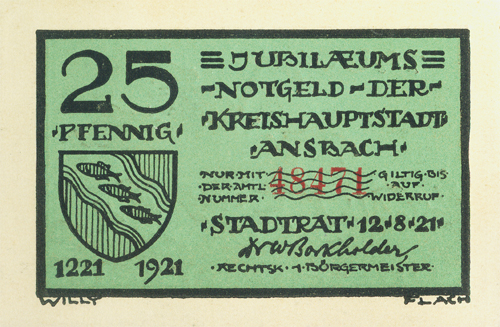 |
|
(COMMON REVERSE) Stadt Ansbach 25 Pfennig: The common reverse for all of these notes depicts the Coat of Arms of the city and the dates 1221 and 1921. The text reads: Jubilaeums notgeld der kreishauptstadt Ansbach (Anniversary Jubilee - Notgeld of the District Capitol Ansbach ) nur mit der amtl nummer 48471 giltig bis auf widerruf (Only with the registration number 48471 valid until revoked) Stadtrat 12.8.21 N.W. Boncholder Burgermeister (City council 12.8.21 N.W. Boncholder Right Mayor) / Bottom text (outside box): 'Willy' left, 'Flach' right |
 |
Stadt Ansbach 25 Pfennig: The Obverse shows the date 1221 which is the year Ansbach was first called a town. It depicts a scholar, probably a monk in reference to the Benedictine monastery founded there. He is surrounded by books, a crucifix, an hourglass, and a cat. The text reads: Die Urkunde (The Instruments) |
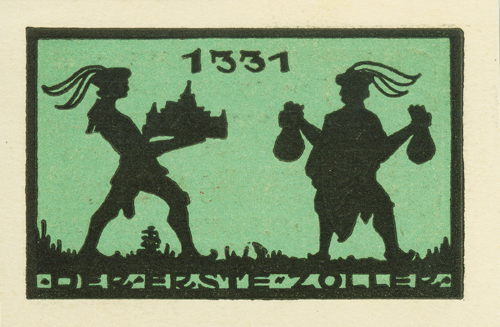 |
Stadt Ansbach 25 Pfennig: The Obverse shows the date 1331 which is the year rule over Ansbach passed from the Counts Oettingen to the Hohenzollern Burgraves of Nuremberg who made it the seat of their dynasty for a time. It depicts a man holding town and another with bags of money. The text reads: Der Erste Zoller (The First Customs) |
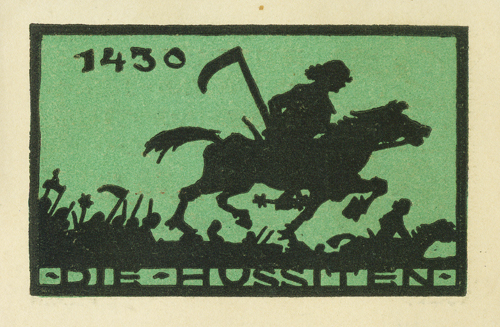 |
Stadt Ansbach 25 Pfennig: The Obverse shows the date 1430 which is the year rule over Ansbach passed from the Counts Oettingen to the Hohenzollern Burgraves of Nuremberg who made it the seat of their dynasty for a time. It depicts soldiers, presumably Hussites, a reference to the Hussite Wars. The text reads: Die Hussiten (The Hussites) |
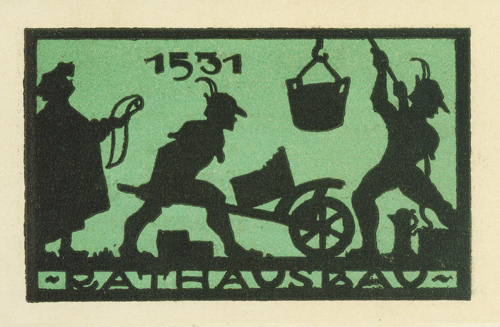 |
Stadt Ansbach 25 Pfennig: The Obverse shows the date 1531. It depicts builders engaged in construction. The text reads: Rathausbau (Building Town Hall) |
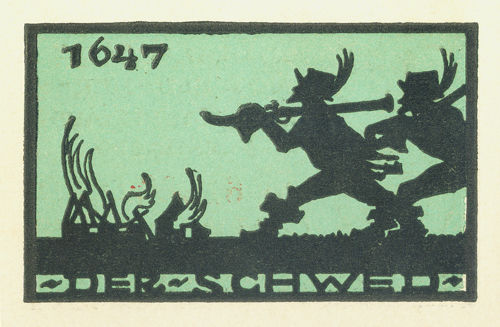 |
Stadt Ansbach 25 Pfennig: The Obverse shows the date 1647, this is close to the end of the 30 years war. The Truce of Ulm was sign this year between Bavaria, Cologne, France and Sweden. It depicts soldiers marching as houses burn in the distance. The text reads: Der Schwed (The Swede) |
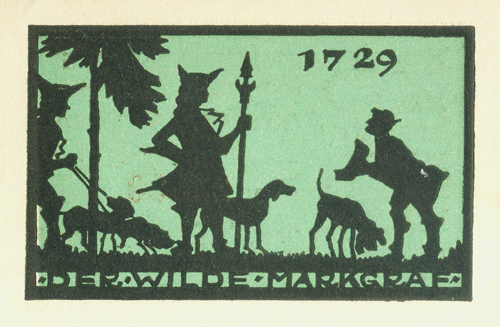 |
Stadt Ansbach 25 Pfennig: The Obverse shows the date 1729, this is the year Karl Wilhelm Friedrich became Margrave of Brandenburg-Ansbach. He was nicknamed the 'Wild Margrave' for his love of hunting on which he spent 10% of his state budget. It depicts the Margrave out hunting with dogs while still conducting business. The text reads: Der Wlde Markgraf (The Wild Margrave) |
 |
Stadt Ansbach 25 Pfennig: The Obverse depicts soldiers and shows the date 1805. This is making reference to the Battle of Ulm, specifically Jean Bernadotte, Marshal of the French Empire and Governor of Hanover, who played a pivotal role in that battle. The text reads: Bernadotte (Referring to Jean Bernadotte, later to be known as Charles XIV, King of Sweden and Norway) |
Ansbach is a large town and the capitol of the administration region of Middle Franconia, Bavaria, Germany. Originally the site of a Benedictine Monastery founded by a Frankish Noble Gumbertus. The monestery and the adjacent town of Onolsbach became Ansbach which was first mentioned in 1221.
Originally under the rule of the counts of Oettingen it eventually became a possession of the Hohenzollern margraves of Nuremberg who made it their capitol in 1331. After 1440 it was a part of the independent margraves of Brandenburg-Ansbach one of which, George the Pius, was a great supporter of Martin Luther and the Protestant Reformation.
Ansbach was annexed by Prussia in 1792. Prussia in turn ceded it to Bavaria in exchange for the Duchy of Berg in 1806. Although it was home to a concentration sub camp and several air bases during World War II, it was largely unharmed during that war and retains its baroque style first introduced in the late 17th century. Today the town is an administrative center that retains much from its historic imperial past. |








